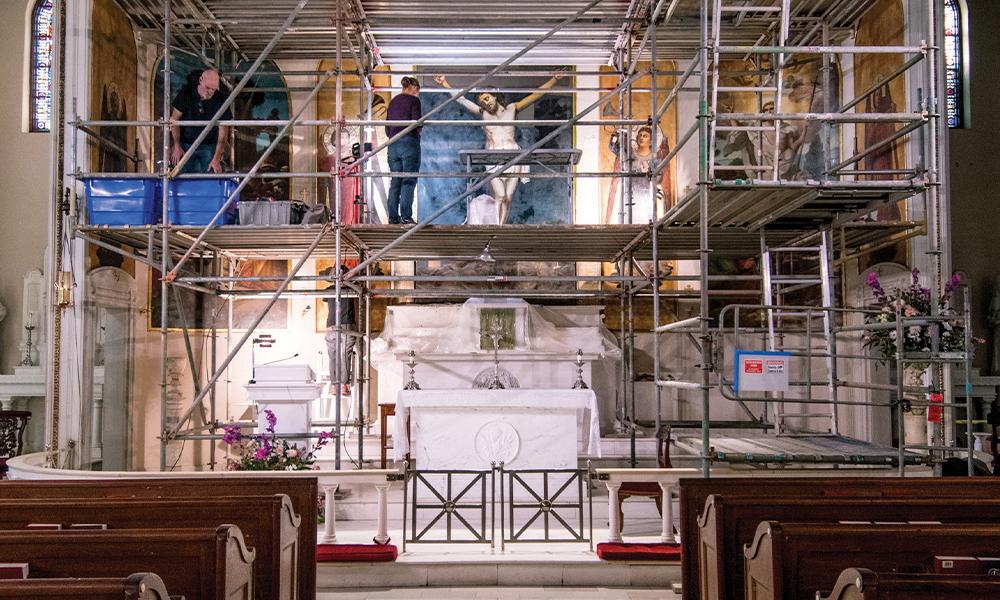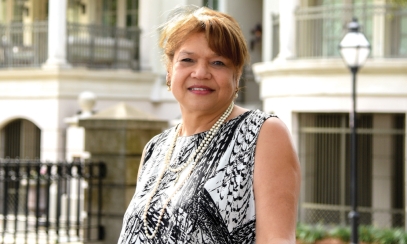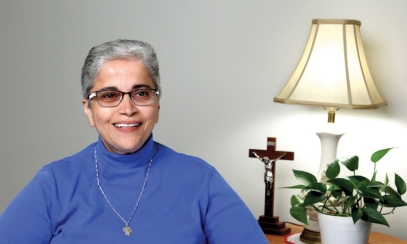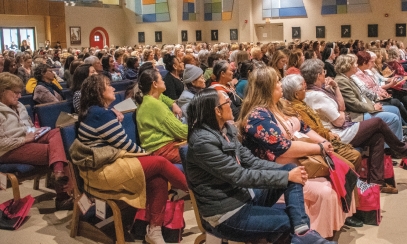
Restoring Life to the Paintings of St. Mary
The history of the artwork inside St. Mary of the Annunciation Church is just as colorful as the paintings themselves. However, it took the services of an art restoration professional to bring those colors out for everyone to see once again.
The history of the artwork inside St. Mary of the Annunciation Church is just as colorful as the paintings themselves. However, it took the services of an art restoration professional to bring those colors out for everyone to see once again.
It began in 1814 when John Stephen Cogdell, a local artist, painted the crucifixion scene behind the altar of St. Mary, located at 95 Hasell Street in downtown Charleston. The church was already a quarter of a century old, since St. Mary was established in 1789 and was the first Catholic church in the diocesan region that, at the time, encompassed all of the Carolinas and Georgia.
The parish survived many disasters over its long history. The first was a massive fire in 1838. Cogdell’s painting was damaged but not completely destroyed. Still it needed to be restored, so in 1839, the painter returned to restore his then 25-year-old masterpiece.
The artwork also survived the Civil War. During the siege of Charleston in the early 1860s, the church took damage from artillery rounds that impacted the graveyard and obliterated several tombstones. At least one round pierced the building and destroyed the organ, while several other volleys caused minor external damage.
Then, there was the earthquake of 1886, which impacted only the portico area of the building, again sparing damage to the painting of the crucifix. The church also survived many hurricanes, including a major one in 1893 and Hurricane Hugo in 1989.
A family history
It was in 1896 that more wall paintings were added, including those on the ceiling. These six paintings, which flank the crucifix, have great significance, especially to Theodora Simons, who is the granddaughter of one of the women painted on the wall.
Simons’ grandmother Emèe Wilbur and her sister, Louisa Storen, were members of St. Mary who went to Rome in the late 1880s. They came back with artist Caesare Porta, who painted the angels, other images behind the altar and some on the ceiling. The faces of the angels are those of Wilbur and Storen and were completed around 1895.
“I grew up knowing that was my grandmother’s face,” Simons said.
The sisters were wealthy and owned real estate on King Street. Being devout parishioners of the church, they lent some of their commercial space for Masses when the church was undergoing repairs after another, later fire.
They dedicated the altar to their parents — George and Carolina McNulty — in the late 1890s after all work was complete. A dedication plaque still adorns the altar’s right side.
The paintings have endured it all, but not without wear, tear, soot and grime.
St. Mary settled on extensive renovations of the church’s entire campus, an effort that began in early 2020.
Renovation and restoration
John Cahill is a parishioner who is also on the renovations committee. “We began the work three years ago. We first painted the exterior of the church and renovated the sacristy, which [were phases] one and two,” he said. “The third phase of the project was the full rehabilitation of the parish hall and rear courtyard,” which was completed in March 2023.
“All of this has been funded by some savings and significant gifts and pledges by parishioners. The fourth phase of the project is the restoration of the interior of the sanctuary, organ and vestibule. This will occur intermittently as funds become available,” Cahill said.
The restoration of the paintings fell into the second phase of the project. Thanks to parishioner donations, most of which were anonymous plus one principal anonymous donor, the restoration of the paintings was completely covered.
Catherine Rogers of Rogers Art Conservation was hired as the lead conservator. She and her crew, including Craig Crawford who also works in conservation, began work in January 2022. She said that they started with restoring the resurrection painting, which is to the right of the crucifixion. In July and August, they worked on the six saints on the balcony, and in September 2022, they got to work on the crucifixion.
Rogers said a restoration was made to the paintings sometime in the 1930s, and in 1961 the paintings went through a complete overhaul. It meant that the original paintings were actually changed and altered in many ways, making her job in 2022 much more of a significant and true restoration to how the paintings were originally intended by Cogdell.
Rogers said that they first had to remove the grime layer and overpaint. She said there were two different layers of that. They had to remove the varnish layer in order to really get down to original paint. Once they were able to uncover the original, they filled in many of the losses and in-painted them, then varnished it with a material that wouldn’t yellow over time.
She admitted that getting to that original layer was surprising.
“We didn’t want to obstruct the original painting. We wanted to be liberal with our applications for the most part,” she explained. “We really only dealt with the damage. It was important to match the original design and make it so that you couldn’t see the loss over time.”
Rogers said that the restoration in 1961 changed many of the colors and the faces of the figures, adding that one of the paintings had been altered to the point that a figure had two noses.
“It is sad when something like this happens to a painting because many people don’t even realize it,” Rogers said.
For 100 years more
The parish is invested in keeping this restoration for the long haul. A humidity regulator will be installed to stabilize the air so the southeastern humidity won’t damage the paintings. And Rogers said that the church is dedicated to making sure that there is a strong lighting source that won’t accentuate cuts and tears, or make the canvases appear distorted. She said this restoration should last for two generations, or “100 years unless there is accidental damage.”
She also noted that the church embarked on the restoration because of parishioner feedback that the paintings are the most important decoration in the church.
“It was sad for parishioners to see the pealing and imperfections of the paintings ... they are irreplaceable,” she said. “They are 125 years old, and the crucifix is 210 years old. That history is just so rich. We found some dark blue around in the crucifix painting that had been hidden since the 1960s. People lost that intensity, and now they will have it again.”
The ceiling paintings will be the next endeavor, hopefully completed sometime in 2024.
“Getting this done is really a tribute to Charleston in a sense,” Rogers added. “They should be treated like valuable museum paintings.”
According to Msgr. D. Anthony Droze, pastor, “Visitors come in here, and they say that this is the Sistine Chapel of Charleston. It’s just so unique and we value that.”
Addendum
Renovation efforts began in 2018 with Father H. Gregory West, then pastor, who met with parish leaders to devise a four-phase renovation of the church and hall. The original plan and work completed were as follows:
- Phase 1 was the repainting of the entire church exterior, especially to cover the marbleized paint on the portico columns.
- Phase 2 was gutting and repurposing the back rooms of the church, including the sacristy. The work began in mid-2019 and was completed in June 2020.
- Phase 3 was gutting and repurposing the parish hall and courtyard. The design was completed in spring of 2020, and construction began in fall of 2020.
- Phase 4, the painting restoration, began in the fall of 2020.
Theresa Stratford is a freelance writer for The Miscellany. She lives in Charleston with her husband and three children and attends the Cathedral of St. John the Baptist. Email her at tmmart89@gmail.com.









